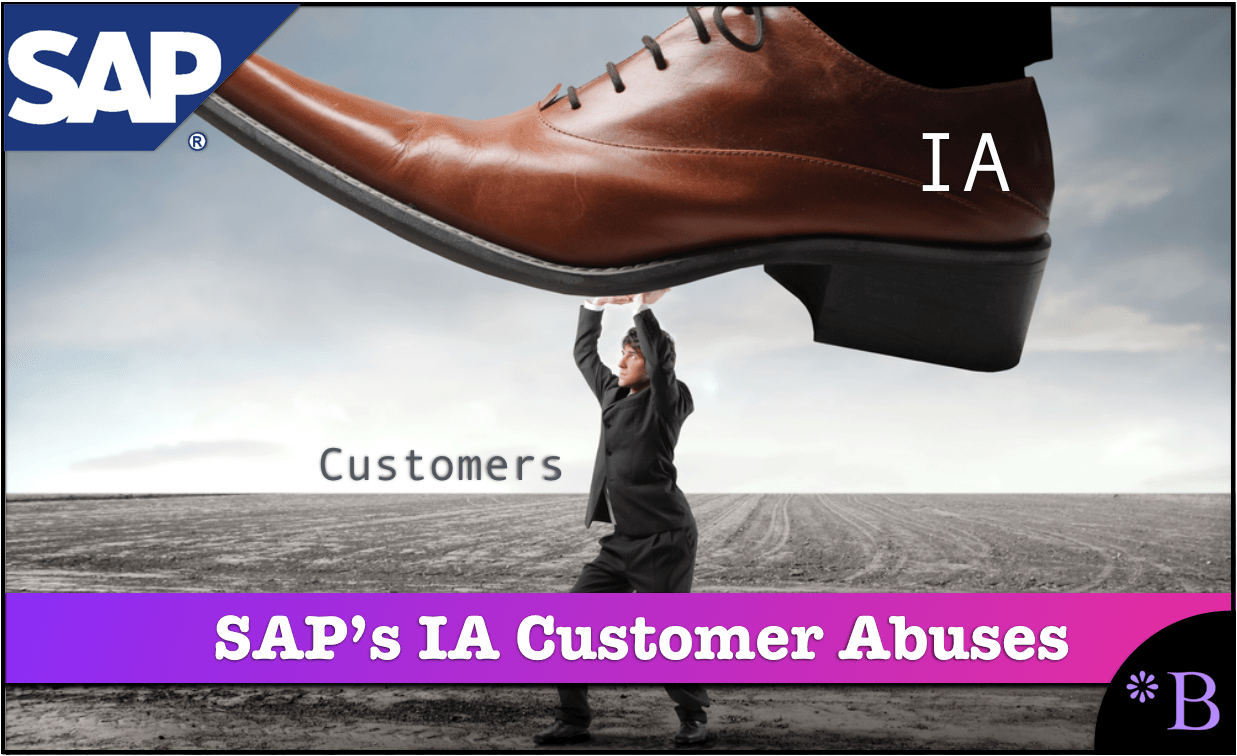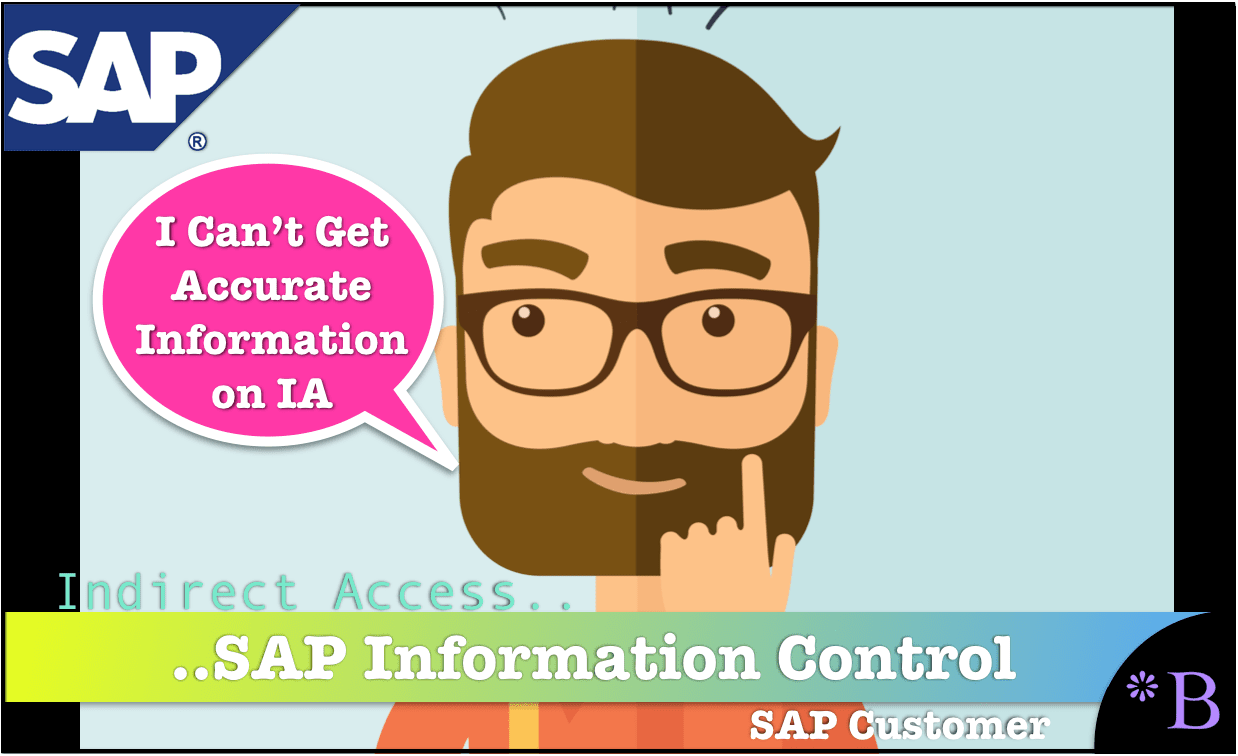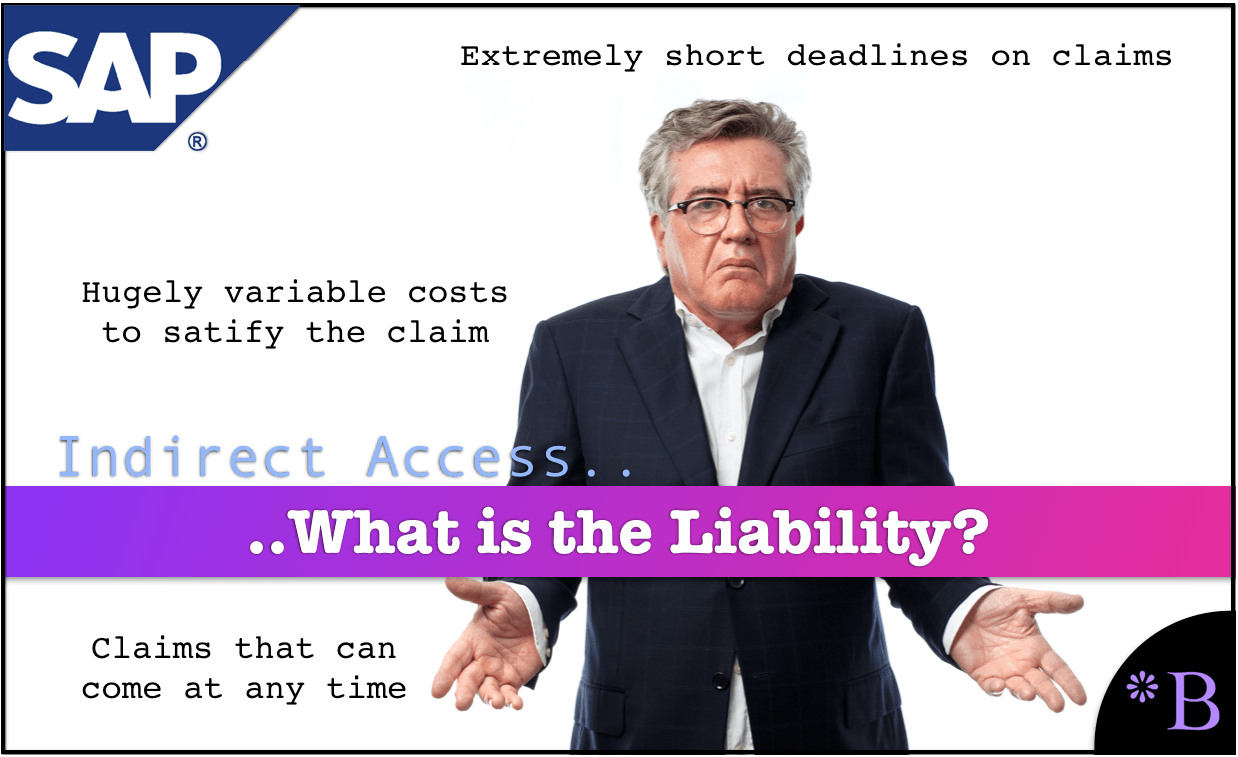How to Understand SAP Indirect Access as an Abusive Relationship
Executive Summary
- The way that SAP uses indirect access against companies is abusive.
- Indirect access means engaging in high-pressure tactics to extract undeserved monies from customers.

Introduction
I recently found an interesting article from UpperEdge on the topic of indirect access. Like me, UpperEdge can tell the truth about indirect access in the way that an entity that accepts money or is an SAP partner can’t.
However, something in a recent article from UpperEdge got me thinking about what it translates to and how that connects to abusive relationships.
See our references for this article and related articles at this link.
How Strong is Your Relationship with SAP?
One of the most impactful areas of the article is in the following quote, where UpperEdge asks the SAP customers to ask the strength of their relationship with SAP.
“Our experience shows that company executives are most comfortable navigating their SAP relationship when they fully understand the following:
- How strong and of what quality is my SAP relationship? (emphasis added)
- What is the overall quality of my commercial agreement with SAP?
- What is my true utilization of the SAP software given what I bought and deployed and what optimization opportunities exist?
- What is my overall compliance risk, inclusive of direct and indirect use?
- Given my future demand profile with SAP, what should my next-generation relationship look like with SAP?
In summary, the issue of use by way of indirect access is not going away. SAP firmly believes it has the right to protect its intellectual property and believes it should to protect the value of its software. SAP customers are well advised to proactively assess their SAP relationship in a holistic manner as outlined in the 5 points above.”
This is eyebrow-raising. UpperEdge is right here, but it is the implication that is bothersome and should be discussed.
Interpreting What Strength of Relationship Means
If we unpack this, we can see the following:
- What is the best way to improve the strength of your relationship with SAP?
- What would make the SAP account executive most pleased with you?
That is right to purchase some SAP software. The account executive is not only looking at your present purchases but is estimating the potential for your future purchases.
And alternatively, what would worsen your relationship with SAP?
- Either not buying more software licenses.
- In particular, you are not showing the signals that you intend to buy a substantial amount of licenses in the future.
The SAP Account Executive’s Expected Sales Level
We are talking about what I have coined the ESL or the expected sales level for the account on the part of the account executive. This may seem strange, but it is the level of entitlement that exists at SAP. In SAP’s view, their customers owe them a particular level of revenue.
This means that the more the customer buys from SAP, the lower your potential for receiving indirect access charges. If the account executive sees current or potential future sales that are in line with their TSL, then indirect access probably won’t come up. But if they don’t, then indirect access has a far higher likelihood of being brought up.
What I noticed is how close this is to the definition of an abusive relationship. Abusive relationships occur when one of the parties can do something that is not considered part of the normal connection to gain the other party’s power. Verbal abuse, controlling behavior, physical abuse all have their foundations in the same motivation factor.
That is the desire to get the other party to do what the abusing party wants. Abusive relationships also have a cycle.
The Standard Cycle of Abusive Relationships
According to Wikipedia, abusive relationships tend to have the following repeating cycle.
- Step 1: Gain Trust
- Step 2: Overinvolvement
- Step 3: Petty Rules and Jealously
- Step 4: Manipulation, Power, and Control
- Step 5: Traumatic Bonding
If we look at SAP and its use of indirect access, we can assign it to this cycle.
Step 1: Gain Trust
This occurs during the sales phase.
At this stage, prospects are told all manner of falsified concepts, including the idea that SAP contains all best practices. This is covered in the article The Evidence for SAP’s Best Practice Claims.
They are told that the project will have a positive ROI. SAP only recommends the consulting companies with the highest standards that the project will implement quickly because of SAP’s ASAP methodology.
Overinvolvement
After SAP, a consulting partner implement software, they know everything about that company, and they seek to control the IT spend at the account. This can happen with any software category, but it is essential when the ERP systems are involved, and SAP uses the ERP system as the queen on a chessboard. This is covered in the article How ERP Systems Were Trojan Horses.
Petty Rules and Jealously
On SAP projects, and I have been on many, all the current systems at a client are discussed in derogatory terms. SAP leads the industry in using the term “legacy” to reduce the status of all systems that the client already had purchased. This is covered in the article How SAP Misused the Term Legacy.
When it comes to other systems, everyone from consulting companies to independent SAP consultants proposes that all purchases be kept with SAP regardless of the fit with the requirements or the system’s features versus competitors.
Fallacious arguments are presented that all integration is essentially a sin, and therefore the way around it is to purchase SAP.
Manipulation, Power, and Control
Both SAP and SAP consulting companies are highly manipulative entities. When I worked at KPMG, the phrase that one partner used was that one should
“penetrate and radiate the account.” – KPMG Partner
That means to get business doing one thing and then look around to other work while doing the initial work. KPMG wanted its senior members to do what they could to control the account. But none of the partners I worked with at KPMG seemed to care about whether they told the account was accurate. Both SAP and the consulting companies set forth a series of rules and simplistic platitudes that, if followed, lead the customer to purchase more SAP and more SAP consulting services. All other software vendors are excluded. Most of the statements made by SAP and consulting companies ranging from the expected ROI of ERP projects to the difficulty in integration applications, are either directly contradicted by academic research or through experience on projects.
Traumatic Bonding
When indirect access is applied, this is the abusive event used by SAP to cut off the options of their customers that have the nerve to begin exploring alternatives outside of SAP. The intent is to bring the customer to heel and understand their place, which is, of course, under SAP. Optimally, the customer thinks twice before ever exploring a non-SAP alternative in the future.
SAP has effectively used its control over media, private messaging, and now the Diageo case in the UK to make their Type 2 version of indirect access seem more valid than it is.
The Importance of Bonding After the Traumatic Event
After the traumatic event, SAP will then attempt reconciliation. Some account executives talk about “repairing” the relationship after they have enforced indirect access to a customer. Well, of course, the SAP account executive needs to continue to sell into the account. If you look at abusive relationships, they swing between periods of non-conflict and then traumatic bonding. That is, “sugar” is added to the sour notes. Links that are 100% sour can’t last, and the abuser knows this.
Well, of course, the SAP account executive needs to continue to sell into the account. If you look at abusive relationships, they swing between periods of non-conflict and then traumatic bonding. That is, “sugar” is added to the sour notes. Relationships that are 100% sour can’t last, and the abuser knows this.
“This article captures the main discussion points and actions from two Special Interest Group (SIG) meetings regarding SAP Licensing.”
This quotation is from SIG.
“SIG participants questioned why SAP would want to clarify indirect access, since it such a cash cow and they greyness in license terms allows them to drive their commercial agenda. The standard response from SAP to licensing ambiguity is “Come and talk to us”. Yet SIG members stated that SAP was the last place they would ask for clarity, since that would initiate an audit or sales enquiry. “[SAP] That would be the last place we go for licensing information” “[I’m] very paranoid about approaching them” This is akin to trying to find a competitive quote for new tires for your car, but having to go back to your old tire supplier to work out how to get the wheel nuts off. It is a RESTRICTIVE and UNCOMPETITIVE.”
Come into My Lair, Said the Spider to the Fly
Something about this is reminiscent of this poem.
“Will you walk into my parlor?” said the spider to the fly;
“’Tis the prettiest little parlor that ever you did spy.
The way into my parlor is up a winding stair,
And I have many pretty things to show when you are there.”
“O no, no,” said the little fly, “to ask me is in vain,
For who goes up your winding stair can ne’er come down again.”
This is accurate. Talk to us is a standard line to get more business. The participant is wise to see it for what it is.
“In the case of Diageo, they were trying to explore an alternative system using Salesforce.com, which free competitive markets should allow them to do. The general consensus from SIG participants was that, whilst Diageo was not a landmark legal case, it would give SAP enough ammunition to give their customers the heebie-jeebies. “SAP will be after everyone” stated one SIG member. Customers are using SAP beyond what could be imagined when the contracts were created (Mobile, Internet, Virtualization, Ecommerce etc.) and SAP’s archaic contracts and manipulative approach to licensing is LIMITING INNOVATION.”
Type 1 Versus Type 2 Indirect Access
As I have in my other articles, I wanted to clarify that there are two types of indirect access. One is legitimate and is what I call Type 1, and the other is what SAP enforces, which is called Type 2. These are explained in the article Type 1 Versus Type 2 Indirect Access. So I am not proposing that all indirect access lacks legitimacy. Type 1 indirect access violations do occur, and it’s just that they are uncommon.
Type 2 indirect access is nefarious because any SAP system connection could be classified as Type 2 indirect access. People who try to view indirect access as merely a matter of having the indirect access clause of an SAP license agreement either don’t get it or mislead their readers. Type 2 indirect access is new in the past few years and is almost exclusively employed by SAP (versus other vendors). Secondly, SAP does not hold to a position that a customer must pay the indirect access charges. No. SAP wants the customer to make other license purchases in return for dropping the indirect access charge.
How This Enables SAP to Achieve its Objectives
This allows SAP to do what SAP wants, which is to grow license revenue, and for the customer to feel like they are paying for something of value, rather than merely paying indirect access fees. SAP wants to pose for investors and other customers that its customers are “choosing to” purchase SAP. They do not wish the broader market to know that they are coercing customers into purchasing SAP’s software that customers do not want to buy. SAP likes to maintain the illusion that they compete and win the business they get because the software’s value is so outstanding.
The following quote from SIG validates this.
“SIG participants suggested that indirect claims were predatory, and that spending money with SAP made spurious indirect access claims go away. Spend money, or buy strategic growth products important to SAP such as HANA. One SIG member quoted their SAP account manager who said “wouldn’t it be easier just to settle with us and pay than to go to court”. Tantamount to BLACKMAIL.”
Let the Shenanigans Begin
So SAP will pull all manner of underhanded shenanigans in private, including things that appear to be blackmail to clients, all while presenting the face of being a completely normal and honest company just selling software and delivering fantastic value to companies with enormous innovation.
If we want to see how SAP projects itself, that can be found in the 2017 Q1 analyst call.
“The facts show that we are executing our winning strategy at scale. Our customers are endorsing the unique breadth and depth of SAP core cloud networks, and all come with soaring adoption for our new innovation on a global basis. We believe SAP is the only company in the business software industry to deliver soaring cloud growth and double-digit license growth.
Driven by S/4HANA, our core innovations are growing really fast with software licenses up 13%. We now have more than 5,800 S/4HANA customers with global companies like Energy SE, choosing S/4 in the first quarter. Big brands like Citrix Systems selected S/4 cloud edition, the leading intelligent cloud ERP solution in the market by far.”
I am continually reading SAP’s material, and I can’t find anywhere that SAP admits to coercing customers into buying software with indirect access claims. I can’t find anywhere that SAP admits to only charging extra fees for ERP licenses if a customer chooses Salesforce but not charging for the ERP licenses if the customer chooses SAP CRM.
This is why I have researched how SAP’s use of Type 2 indirect access falls under an antitrust provision, as covered in the article on How SAP’s Indirect Access Violates US Law on Tying Agreement.
SAP presents all its revenues as if this is based on customer choice, all while doing as much as possible to restrict selection in each customer situation.
Conclusion
There is something very wrong with responding to being shaken down by SAP on Type 2 indirect access by ensuring that you are meeting the SAP account executive’s ESL.
SAP is trying to have its cake and eat it too. They also want to keep IA as quiet as possible and spring it on customers at the time of their choosing. New accounts are not being told about IA during the sales cycle. Type 2 IA is something you use on a customer most often years after the sale is made and the software is implemented. Indirect access is used when the company is many millions of dollars down the road and when their SAP’s leverage is at its maximum. And like an abusive relationship, after SAP uses IA against a customer, they want to repair the relationship afterward.
With the significant consulting companies recommending SAP no matter what the quality, maturity, capabilities regarding the other offerings in the market, or fit with client business requirements combined with indirect access. The one thing SAP does not want to do is compete on a level playing field against other software vendors.

The Problem: Secrecy Around Indirect Access
Oracle, SAP, and their consulting partners, ASUG, and the IT media entities all have something in common. They don’t want indirect access understood. Media outlets like Diginomica are paid to distribute PR releases as articles, as we covered in the article SAP’s Recycled Indirect Access Damage Control for 2018. The intent is to lower SAP customers’ concern around indirect access so that indirect access is underestimated, as we covered in the article The Danger in Underestimating SAP Indirect Access.

The primary providers of information in the SAP space are all financially linked to SAP. SAP does not want indirect access understood, so these entities do as they are told by SAP.